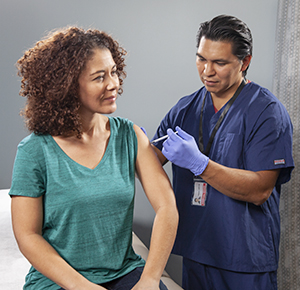Corticosteroid Shots
Corticosteroids are medicines used to reduce inflammation in the body. They can come in several forms. These include pills, creams, sprays, and shots (injections with a needle). This information below talks about treatment using corticosteroid shots.
These medicines are different from anabolic steroids. Anabolic steroids are used illegally by some athletes to increase muscle tone.

How corticosteroid shots are used
Corticosteroid shots can treat many problems of muscles and bones. Shots may be done by your healthcare provider in their office. Or you may need to see a pain doctor or other specialist.
Here are some conditions that these shots can treat:
-
Osteoarthritis (OA). People with OA often have pain and inflammation in their joints. A shot into the affected joint can give pain relief for weeks or months. After the treatment, you may be told not to do a lot of activity for at least 24 hours.
-
Low back pain. Low back pain can be caused by a ruptured disc, spinal stenosis, or some other condition. Pain from these may be treated with shots. Lumbar radiculopathy is pain in the buttocks, hips, or legs. It's caused by a pinched nerve in the lower back. This type of pain can often be treated with corticosteroid shots near the pinched nerve. Other medicines like local anesthetics may be given along with this injection.
-
Cervical radiculopathy. This is neck pain that also goes into the shoulder, arm, or hands. It happens when the vertebrae in the upper spine move too close together. Or it happens when a disc bulges or tears. These problems can pinch a nerve in the neck. Shots given near the nerve may reduce swelling and pain. This gives the nerve time to heal.
-
Bursitis and tendonitis. Bursitis is a common condition. Bursae are small sacs of fluid. They cushion the spaces between bones, muscles, and skin. Bursitis is when one or more of these sacs is inflamed and painful. Tendonitis is also common. The tendons around muscles and bones become inflamed. This can happen more often in the elbow, knee, shoulder, wrist, hand, or hip. Shots can reduce the inflammation. But repeated steroid use can cause the tendon to weaken or even tear.
-
Carpal tunnel syndrome. This is when a nerve in the wrist is compressed or pinched. This leads to pain, numbness, and tingling. It may also cause weakness in the hand. Shots into the wrist can give fast, short-term relief. An anesthetic, such as lidocaine, may also be given with the steroid.
Side effects of corticosteroid shots
Short-term side effects of corticosteroid shots can include pain or infection at the injection site.
Your healthcare provider may limit the number of shots you get based on your condition. This is because they can have more serious side effects. This includes high blood sugar levels. If you have diabetes, tell your provider before taking steroid medicine.
Having shots for a long time can cause other side effects. These can include:
-
Weak, brittle bones (osteoporosis)
-
Cataracts and glaucoma
-
Delayed growth
-
Stomach ulcers
-
Skin atrophy
-
Skin gets lighter or loses color (depigmentation)
-
Mood disorders
-
High blood pressure
-
Higher risk of infections
-
Weight gain
Talk with your healthcare provider about the benefits and risks for you.
Online Medical Reviewer:
Jimmy Moe MD
Online Medical Reviewer:
Rita Sather RN
Online Medical Reviewer:
Tara Novick BSN MSN
Date Last Reviewed:
12/1/2022
© 2000-2025 The StayWell Company, LLC. All rights reserved. This information is not intended as a substitute for professional medical care. Always follow your healthcare professional's instructions.